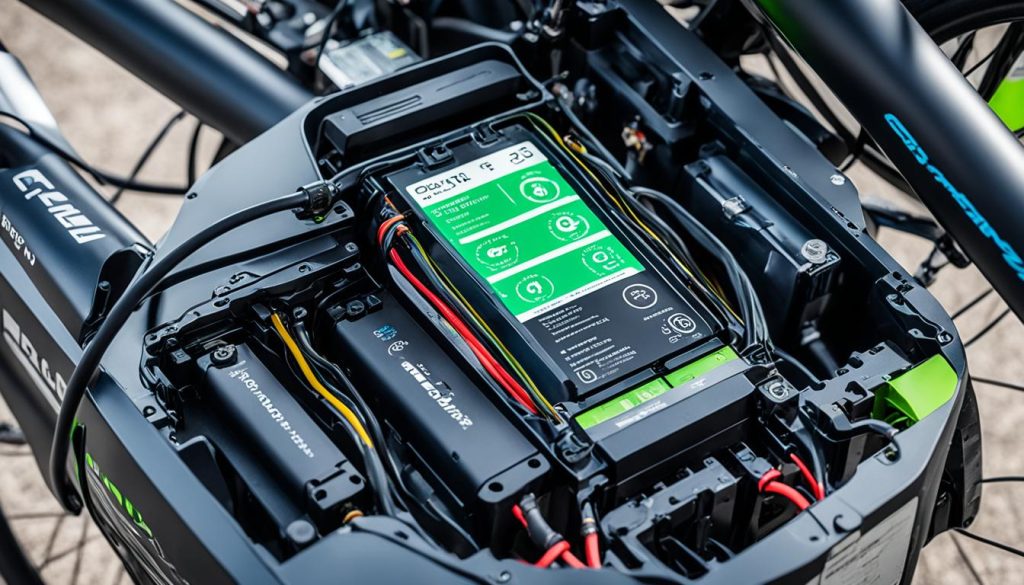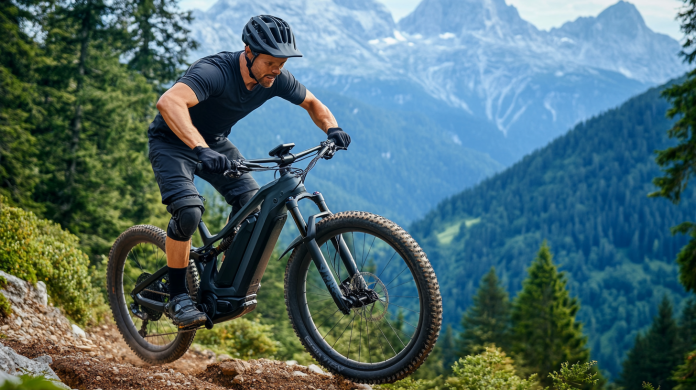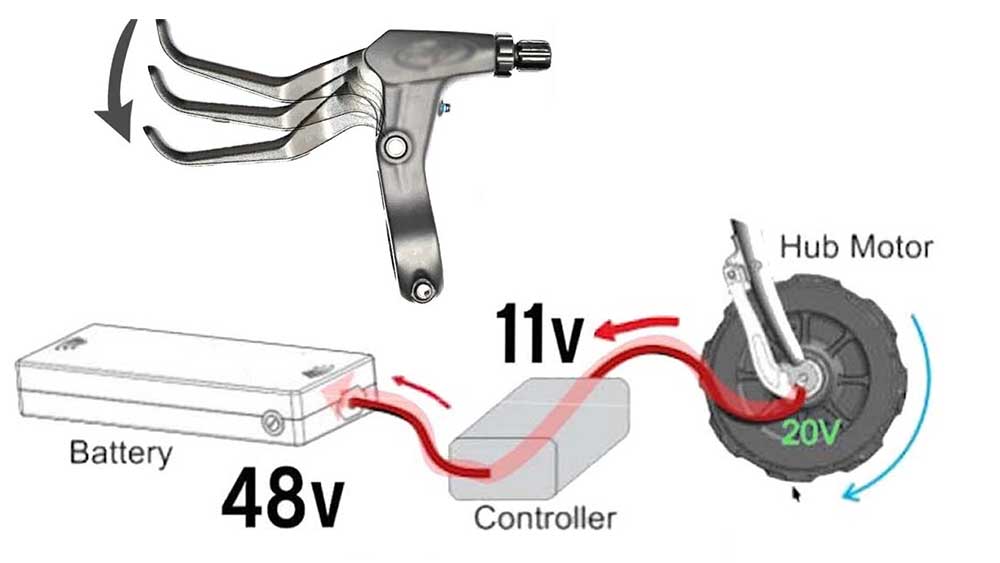Did you know some mountain eBikes can go up to 300 miles on one charge? This amazing range is changing how riders tackle long trails and adventure cycling. As electric bikes become more popular in the USA, knowing about battery life on mountain ebikes is key for both new and seasoned cyclists.
The battery life of mountain eBikes can vary a lot, usually offering 50-70 miles of help. But, top models like the Optibike R22 Everest claim up to 300 miles. These big ranges are making longer rides easier than ever.
Table of Contents

When looking at electric bikes in the USA, think about what affects battery performance. Things like the terrain, your weight, the weather, and how you charge it matter a lot. For example, a 48V/12Ah battery usually gives you 25-30 miles, but this can change based on these factors.
At ebikeus.com, you’ll find many electric mountain bikes with different battery sizes. The Revi Bikes OG Cheetah Fat Tire Electric Bike has a 48V/17.5Ah battery for a 45-mile range. It’s important to know your riding needs and the battery’s lifespan to pick the right bike for your adventures.
To get the most out of your electric mountain bike battery, try to carry less weight, keep your tires properly inflated, and ride at a steady speed. Regular care and proper storage can also make your battery last longer. This way, you’ll enjoy your electric bikes in the USA more.
Key Takeaways
- Mountain eBike battery ranges vary from 50-300 miles per charge
- Factors like terrain, rider weight, and weather affect battery performance
- Lithium-ion batteries are the industry standard for eBikes
- Proper maintenance can extend ebike battery lifespan
- Choose an eBike based on your specific riding needs and desired range
- Regular charging and avoiding overcharging help maintain battery health
Understanding E-Bike Battery Types
Exploring ebike battery types shows us three main options: lithium-ion, nickel-cadmium, and lead-acid. Each type has its strengths and weaknesses. These affect how well they perform and fit your riding needs.
Lithium-ion Batteries: The Industry Standard
Lithium-ion batteries lead the ebike market for their top-notch performance. They pack a lot of energy in a small space, giving you a longer ride on a single charge. On average, you can go about 20 miles per charge with a 6 to 8 lbs lithium battery.
They’re also light and last a long time. You can expect them to last 500 to 1,000 full-charge cycles or about 25,000 miles before they start losing power.
Nickel-Cadmium Batteries: An Older Technology
Nickel-cadmium batteries used to be popular in ebikes. They’re tough but don’t hold as much energy as lithium-ion batteries. Now, they’re less common because of environmental worries. Yet, some riders still like them for their dependability in harsh weather.
Lead-acid Batteries: Budget-Friendly Options
Lead-acid batteries are the cheapest option for ebikes. They’re heavier and don’t last as long as lithium-ion or nickel-cadmium batteries. These batteries give you less power and charge slower, making them good for basic or budget ebikes.
| Battery Type | Weight | Lifespan | Cost |
|---|---|---|---|
| Lithium-ion | Light | 500-1000 cycles | High |
| Nickel-Cadmium | Medium | 300-500 cycles | Medium |
| Lead-acid | Heavy | 200-300 cycles | Low |
Knowing about these ebike battery types helps you pick the best one for your riding style and budget. Think about weight, range, and how long they last when making your choice.
Factors Affecting Battery Capacity
Understanding ebike battery capacity is key to getting the most out of your ride. The life of your electric bike’s battery depends on many things, like the terrain and temperature.
The terrain greatly affects how fast your battery drains on trails. Going uphill uses more power while riding on flat ground saves energy. To manage emtb power better, use lower gears on steep hills to ease the battery load.
Weather also plays a part in how well your battery performs. Cold weather can make it less efficient, and very hot weather might cause it to overheat. Try to ride in weather that’s not too extreme for the best results.
Your riding style also impacts how long your battery lasts. Stopping and starting a lot uses more power. To save energy, ride at a steady pace of 80-90 rpm. Using higher pedal-assist levels uses up the battery faster, so use them carefully.
Different e-bikes have different battery capacities. City bikes might get 30-40 miles per charge, while high-end bikes can go up to 200-250 miles with a 3 kW battery. For example, the KBO Ranger can go up to 60 miles on its 840Wh battery.
| E-Bike Type | Battery Capacity | Range (miles) |
|---|---|---|
| City Commuter | 300-500Wh | 30-40 |
| Standard | 400-600Wh | 60-75 |
| High-End | 700Wh+ | 200-250 |
Proper maintenance can help your battery last longer. Keep your battery in a cool, dry spot and charge it as the maker suggests. Taking good care of your battery means it will work better and you can enjoy longer rides.
Battery Life on Mountain eBikes: Key Considerations
When looking at mountain bike battery performance, many factors are key. Knowing these can help you get the most out of your electric mountain bike battery range. This means you can enjoy longer rides.
Terrain Impact on Battery Performance
The terrain you ride on greatly affects your e-bike’s battery life. Riding on steep climbs and rough trails uses more power. This reduces your battery’s range. But, riding on smooth paths and going downhill helps save energy.
Rider Weight and Riding Style
Your weight and how you ride affect how much battery you use. Heavy riders need more power to move. Riding aggressively also uses up the battery faster. But, if you pedal smoothly, you can make your e-bike’s battery last longer.
Weather Conditions and Temperature Effects
Weather is a big factor in how well your e-bike battery works. Cold weather can make the battery less efficient. And, very hot weather can make it degrade faster. E-bike batteries work best when it’s between 5°C and 30°C. Keep this in mind when planning your rides to get the most out of your battery.
| Factor | Impact on Battery Life |
|---|---|
| Steep Terrain | Increases power consumption |
| Heavy Rider | Requires more energy |
| Extreme Temperatures | Reduces battery efficiency |
By thinking about these factors, you can manage your e-bike’s battery better. This way, you can enjoy longer, more efficient rides on different terrains.
Battery Management Systems: Optimizing Performance
Your ebike’s battery management system (BMS) is key to better performance and longer battery life. It keeps an eye on charging rates, temperature, and voltage levels. This helps prevent problems like overcharging, deep discharging, and extreme temperatures.
Using your BMS right can make your battery work better and last longer. It’s important for your ebike’s overall efficiency and performance.

- Cell voltage monitoring
- Temperature regulation
- State of charge estimation
- Balancing cell voltages
- Protecting against electrical faults
These parts work together to help your ebike’s battery last longer and perform well. Knowing how your BMS works can enhance your electric mountain bike experience.
| BMS Function | Benefit |
|---|---|
| Cell voltage monitoring | Prevents overcharging and deep discharging |
| Temperature regulation | Protects battery from extreme heat or cold |
| State of charge estimation | Provides accurate battery level information |
| Balancing cell voltages | Extends overall battery life |
| Fault protection | Safeguards against electrical issues |
By using these BMS features, you can use your battery more efficiently and ride longer on your electric mountain bike. A well-kept BMS is crucial for the best performance and life of your ebike.
Charging Cycles and Battery Longevity
Knowing how charging cycles affect your mountain ebike’s battery life is key. Proper charging can make your battery last longer and improve your rides.
Understanding Charging Cycles
A charging cycle happens when you use 100% of your battery’s power, whether in one ride or many. Most e-bike batteries can go through about 1,000 full charge cycles before they start losing capacity. With regular use, your battery could last 3 to 5 years.
Proper Charging Techniques
To make your mountain ebike battery last longer, follow these tips:
- Avoid leaving your battery charging overnight
- Keep charge levels between 20% and 80%
- Don’t fully drain the battery before recharging
- Unplug the battery when it reaches about 85% charge
Impact of Overcharging and Deep Discharging
Overcharging or deeply discharging your battery can shorten its life. Always stick to the maker’s charging advice. Keeping your ebike in moderate temperatures (35°F to 80°F) and avoiding extreme weather helps too. Proper care means a longer battery life and more fun rides on your mountain ebike.
Maximizing Range: Tips for Efficient Battery Usage
Boosting your ebike battery range is key for longer rides. Using energy-efficient ebike modes and smart riding can greatly increase your range. Here are some tips to use your electric bike’s power better.
Choosing the right ebike is important. Mid-drive motors are more efficient than hub motors, giving you a better range. For off-road, go for bigger batteries like 500Wh or 625Wh. A hybrid design can also help increase range without losing off-road capability.

Your riding style affects your range. Keep pedaling at 70-75 rpm for the best motor efficiency. Use the right gear and pedal hard to save battery. Lowering power and slowing down a bit can also make your ride last longer.
Keeping your bike in good shape is crucial. Do regular tune-ups and check tire pressure. Lubricate the chain to use less energy. These steps can make your bike more efficient and extend your ride.
Temperature affects how well your battery works. The best riding is between 10-20°C (50-68°F). In cold weather, keep your battery indoors to keep it efficient. For long trips, think about electric bike range extenders or a second battery to double your range.
| Factor | Impact on Range | Tips |
|---|---|---|
| Motor Type | High | Choose mid-drive for efficiency |
| Riding Style | Medium | Maintain steady cadence, use appropriate gears |
| Maintenance | Medium | Regular tune-ups, correct tire pressure |
| Temperature | Low-Medium | Ride in 10-20°C, store battery indoors |
By using these strategies, you’ll enjoy longer rides and get the best from your electric bike’s battery. Remember, taking good care of your bike and riding smart are key to getting the most range and performance.
Storage and Maintenance Best Practices
Keeping your ebike battery in good shape is key for its performance and life. Let’s look at some important tips to keep your mountain ebike battery running well.
Ideal Storage Conditions
Store your ebike battery in a cool, dry spot. The best temperature is between 40°F to 70°F. Keep the charge between 40% to 50% when not using it for a while. This keeps the battery healthy and ready for your next trip.
Regular Maintenance Routines
Looking after your ebike battery is easy but crucial. Clean it with a damp cloth, but don’t let it get wet. Check for loose connections and wear regularly. Charge it to about 50% for long storage to keep it healthy.
Troubleshooting Common Battery Issues
If your battery suddenly stops working, check the connections first. For ongoing issues, get expert help. Always put safety first with your ebike battery. Don’t charge it overnight, and use only approved chargers. If your bike gets wet, take out the battery right away to avoid danger.
- Store batteries at 40-50% charge for long periods
- Clean with a damp cloth, and avoid direct water contact
- Check connections regularly
- Use certified chargers for safety
- Remove the battery if bike is submerged in water
By sticking to these tips, your ebike battery will stay in top shape for your next adventure.
Brand Quality and Its Impact on Battery Life
Brand quality is key for high-performance mountain ebike batteries. Top brands like Bosch, Samsung, and Panasonic are leaders in ebike battery tech. They focus on research and development, making batteries that last longer and perform better.
Choosing a well-known brand can save you money on ebike battery replacements. Even though premium batteries cost more at first, they offer great value over time. They usually last 3 to 5 years with the right care, unlike cheaper ones that may need replacing sooner.
High-quality batteries have features that help them last longer. For example, advanced Battery Management Systems (BMS) keep an eye on voltage and temperature. This prevents damage and helps batteries last longer. These systems are key for keeping your ebike running well in different conditions.
“Investing in a quality ebike battery is like investing in peace of mind for your rides.”
A battery’s warranty can show how good it is. Good brands offer longer warranties because they trust their products. By picking a top-quality brand, you’re getting reliability, great performance, and a better ride.
Future Trends in Mountain eBike Battery Technology
The future of mountain ebike battery technology is exciting. We can expect to see energy-efficient ebike batteries that improve performance and are better for the planet.
Solid-state batteries are changing the game for mountain ebikes. They can hold almost twice as much energy as old lithium-ion batteries. This means longer rides and less time spent charging for cyclists.
Charging times will get much faster too. Solid-state batteries can charge up to 10 times quicker than lithium batteries. Just imagine charging your ebike in 20 minutes for a 160-mile ride!
Ebike battery safety is also getting better. Future ebikes will have automatic braking, lane departure warnings, and blind spot detection. These features will make riding safer and more fun.
| Feature | Current Technology | Future Technology |
|---|---|---|
| Energy Storage | Standard | 2x more efficient |
| Charging Time | Several hours | 20 minutes |
| Temperature Range | Limited | -22°F to 122°F |
| Safety Features | Basic | Advanced AI-assisted |
These new technologies are exciting but come with a higher price tag. Solid-state batteries are currently eight times pricier than lithium-ion ones. However, experts believe they’ll become more affordable and common in ebikes soon.
As mountain ebike battery technology advances, we can expect lighter, more powerful, and eco-friendly bikes. The future of ebike adventures is just ahead!
Conclusion
Knowing how long your ebike battery will last is key to a great ride. With the right care, electric bike batteries can go up to 8 years, making your commute green and fun. Brands like Panasonic and Samsung use lithium-ion batteries that pack a lot of energy and last a long time, about 1000 charge cycles.
The range of your ebike battery changes with the terrain, weather, and how you ride. To make your battery last longer, follow some important tips. Keep your battery in a spot between 35° to 80°F, avoid harsh weather, and charge it between 20% and 80%. Always remove the charger when it’s fully charged to stop overcharging.
By sticking to these tips and keeping an eye on your battery, you’ll keep it running well. As technology gets better, we’ll see batteries that work even better and last longer, making your rides even better. For top-notch e-bikes and expert advice, check out Electric bikes USA at ebikeus.com.






